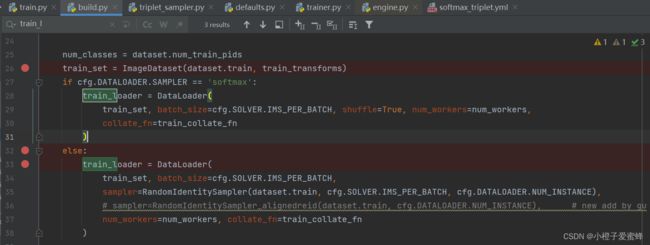行人重识别:reid-strong-baseline-master(罗浩)---triplet_sampler.py(数据加载,迭代器构建)
首先,reid-strong-baseline代码是罗浩博士在CVPR2019发表的《Bag of Tricks and A Strong Baseline for Deep Person Re-identification》,相关代码链接如下:https://github.com/michuanhaohao/reid-strong-baseline。这篇论文对我启发蛮大,也是我入门的基础。我也是小白,代码功底也不是很好,入门比较慢,目前正在研读他的代码。我的代码是在market1501数据集上跑的。
以下所阐述的内容是从以下博客学习来的基于度量学习的ReID代码实现(1)和行人重识别02-06:fast-reid(BoT)-pytorch编程规范(fast-reid为例)3-迭代器构建,数据加载-1。它们对我启发很大。
一、triplet_sampler.py具体位置
在reid-strong-baseline-master/tools/train.py文件中找到train函数的make_data_loader函数。
make_data_loader函数在reid-strong-baseline-master/data/build.py文件中,然后在该函数找到RandomIdentitySampler类。
RandomIdentifySampler类是在reid-strong-baseline-master/data/samplers/triplet_sampler.py文件中。
二、triplet_sampler.py解析
注释如下:
"""
@author: liaoxingyu
@contact: [email protected]
"""
import copy
import random
import torch
from collections import defaultdict
import numpy as np
from torch.utils.data.sampler import Sampler
class RandomIdentitySampler(Sampler):
"""
【首先随机采集N个ID,然后每个ID选择K个实例图像】
Randomly sample N identities, then for each identity,
randomly sample K instances, therefore batch size is N*K.
Args:
【训练数据的列表,包含了所有训练的数据,也就是多个数据源】
- data_source (list): list of (img_path, pid, camid).
【在每个batch中,对每个ID采集num_instances图像】
- num_instances (int): number of instances per identity in a batch.
- batch_size (int): number of examples in a batch.
"""
def __init__(self, data_source, batch_size, num_instances):
# 【包含了多个数据集的训练信息,例如图片路径,身份ID,摄像头编号等】
self.data_source = data_source
self.batch_size = batch_size
# 【对每个身份采集的图像数目,本文设置(num_instances=4)】
self.num_instances = num_instances
# 【通过计算获得每个batch需要采集多少个身份ID,16=64/4】
self.num_pids_per_batch = self.batch_size // self.num_instances
# 【(写了一个dic,dic的key是id,value是各id对应的图片序号)用于存储该图片 序列号 保存于字典,方便查找转换】
self.index_dic = defaultdict(list)
# 【循环把(key:id==>行人的id,即pid)(value:各个id对应的图片序号)数据保存上述字典中】
for index, (_, pid, _) in enumerate(self.data_source):
self.index_dic[pid].append(index)
# 【把index_dic的键值(身份ID)保存于self.pids中】
self.pids = list(self.index_dic.keys())
# estimate number of examples in an epoch
self.length = 0
for pid in self.pids:
idxs = self.index_dic[pid]
num = len(idxs)
if num < self.num_instances:
num = self.num_instances
self.length += num - num % self.num_instances
# 【iter返回的是一个epoch的数据,是一个list】
def __iter__(self):
batch_idxs_dict = defaultdict(list)
for pid in self.pids:
idxs = copy.deepcopy(self.index_dic[pid])
if len(idxs) < self.num_instances:
idxs = np.random.choice(idxs, size=self.num_instances, replace=True)
random.shuffle(idxs)
batch_idxs = []
for idx in idxs:
batch_idxs.append(idx)
if len(batch_idxs) == self.num_instances:
batch_idxs_dict[pid].append(batch_idxs)
batch_idxs = []
avai_pids = copy.deepcopy(self.pids)
final_idxs = []
while len(avai_pids) >= self.num_pids_per_batch:
selected_pids = random.sample(avai_pids, self.num_pids_per_batch)
for pid in selected_pids:
batch_idxs = batch_idxs_dict[pid].pop(0)
final_idxs.extend(batch_idxs)
if len(batch_idxs_dict[pid]) == 0:
avai_pids.remove(pid)
self.length = len(final_idxs)
return iter(final_idxs)
def __len__(self):
return self.length
1.def __init__()函数中的data_source包含很多信息,调试结果如图:
2.def __init__()函数中的num_pids_per_batch参数,很重要:
3.def __init__()函数中for index,(_,pid,_) in enumerate(self.data_source)的解释:
首先,通过for循环将行人id存储在字典里,调试后可看到index_dic字典内容:
【注:pid从0开始,750结束,pid一共751个,即751个人】
更加直观从数据集看:
4.def __init__()函数中self.pids = list(self.index_dic.keys())调试如下:
 5.def __init__()函数中RandomIdentitySampler最终取到的值:
5.def __init__()函数中RandomIdentitySampler最终取到的值:
目录
一、triplet_sampler.py具体位置
二、triplet_sampler.py解析









